
Helen Beatrix Heelis, usually known as Beatrix Potter, was an English writer, illustrator, natural scientist, and conservationist. She is best known for her children's books featuring animals, such as The Tale of Peter Rabbit, which was her first commercially published work in 1902. Her books, including 23 Tales, have sold more than 250 million copies. An entrepreneur, Potter was a pioneer of character merchandising. In 1903, Peter Rabbit was the first fictional character to be made into a patented stuffed toy, making him the oldest licensed character.

Peter Rabbit is a fictional animal character in various children's stories by English author Beatrix Potter. A mischievous, adventurous young rabbit who wears a blue jacket, he first appeared in The Tale of Peter Rabbit in 1902, and subsequently in five more books between 1904 and 1912. The six books by Potter featuring Peter Rabbit have sold over 150 million copies. Spin-off merchandise includes dishes, wallpaper, painting books, board games and dolls. In 1903, Peter Rabbit was the first fictional character to be made into a patented stuffed toy, making him the oldest licensed character.
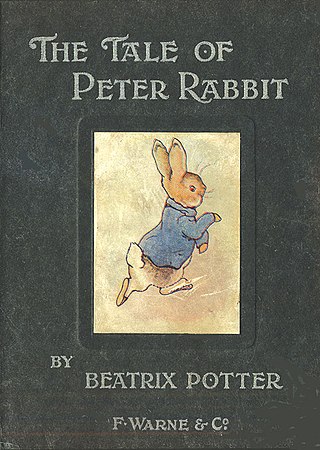
The Tale of Peter Rabbit is a children's book written and illustrated by Beatrix Potter that follows mischievous and disobedient young Peter Rabbit as he gets into, and is chased around, the garden of Mr. McGregor. He escapes and returns home to his mother, who puts him to bed after offering him chamomile tea. The tale was written for five-year-old Noel Moore, the son of Potter's former governess, Annie Carter Moore, in 1893. It was revised and privately printed by Potter in 1901 after several publishers' rejections, but was printed in a trade edition by Frederick Warne & Co. in 1902. The book was a success, and multiple reprints were issued in the years immediately following its debut. It has been translated into 36 languages, and with 45 million copies sold it is one of the best-selling books in history.
Roly poly or Roly Poly may refer to:

Hill Top is a 17th-century house in Near Sawrey near Hawkshead, in the English county of Cumbria. It is an example of Lakeland vernacular architecture with random stone walls and slate roof. The house was once the home of children's author and illustrator Beatrix Potter who left it to the National Trust. It is a Grade II* listed building. It is open to the public as a writer's house museum, shown as Beatrix Potter herself would have known it.

The Tale of Samuel Whiskers or The Roly-Poly Pudding is a children's book written and illustrated by Beatrix Potter and first published by Frederick Warne & Co. in October 1908 as The Roly-Poly Pudding. In 1926, it was re-published as The Tale of Samuel Whiskers. The book is dedicated to the author's fancy rat "Sammy" and tells of Tom Kitten's escape from two rats who plan to make him into a pudding. The tale was adapted to animation in 1993.

Jam roly-poly, shirt-sleeve pudding, dead man's arm or dead man's leg is a traditional British pudding probably first created in the early 19th century. It is a flat-rolled suet pudding, which is spread with jam and rolled up, similar to a Swiss roll, then steamed or baked and traditionally served with custard. In days past, jam roly-poly was also known as shirt-sleeve pudding, because it was often steamed and served in an old shirt-sleeve, leading to the nicknames of dead-man's arm and dead man's leg. In the past it was known as roly poly pudding.

The Tale of The Flopsy Bunnies is a children's book written and illustrated by Beatrix Potter, and first published by Frederick Warne & Co. in July 1909. After two full-length tales about rabbits, Potter had grown weary of the subject and was reluctant to write another. She realized however that children most enjoyed her rabbit stories and pictures, and so reached back to characters and plot elements from The Tale of Peter Rabbit (1902) and The Tale of Benjamin Bunny (1904) to create The Flopsy Bunnies. A semi-formal garden of archways and flowerbeds in Wales at the home of her uncle and aunt became the background for the illustrations.
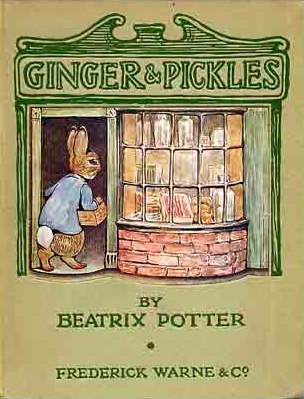
The Tale of Ginger and Pickles is a children's book written and illustrated by Beatrix Potter, and first published by Frederick Warne & Co. in 1909. The book tells of two shopkeepers who extend unlimited credit to their customers and, as a result, are forced to go out of business. It was originally published in a large format which permitted very detailed illustrations and also allowed Potter to include black-and-white vignettes. Potter filled the tale with characters from her previous books. The book was eventually republished in the standard small format of the Peter Rabbit series and was adapted to drama in 1931.

The Tale of Jemima Puddle-Duck is a children's book written and illustrated by Beatrix Potter and first published by Frederick Warne & Co. in 1908. The protagonist Jemima Puddle-Duck first appeared in The Tale of Tom Kitten.
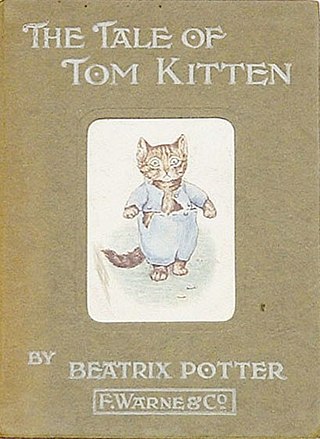
The Tale of Tom Kitten is a children's book, written and illustrated by Beatrix Potter. It was released by Frederick Warne & Co. in September 1907. The tale is about manners and how children react to them. Tabitha Twitchit, a cat, invites friends for tea. She washes and dresses her three kittens for the party, but within moments the kittens have soiled and lost their clothes while scampering about the garden. Tabitha is "affronted". She sends the kittens to bed, and tells her friends the kittens have the measles. Once the tea party is underway however, its "dignity and repose" are disturbed by the kittens romping overhead and leaving a bedroom in disorder.

The Tale of the Pie and the Patty-Pan is a children's book written and illustrated by Beatrix Potter, and published by Frederick Warne & Co. in October 1905. It tells of a cat called Ribby and a tea party she holds for a dog called Duchess. Complications arise when Duchess tries to replace Ribby's mouse pie with her own veal and ham pie, and then believes she has swallowed a small tin pastry form called a patty-pan. Its themes are etiquette and social relations in a small town.
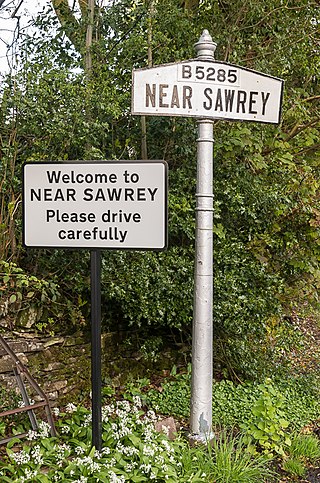
Near Sawrey and Far Sawrey are two neighbouring villages in the Furness area of Cumbria, England. Within the boundaries of the historic county of Lancashire, both are located in the Lake District between the village of Hawkshead and the lake of Windermere. The two lie on the B5285, which runs from Hawkshead to the west bank of the Windermere Ferry, a car ferry across Windermere 1 mile to the east of the villages.
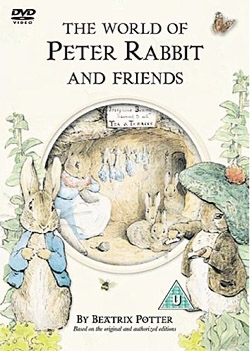
The World of Peter Rabbit and Friends is a British animated anthology television series based on the works of Beatrix Potter, featuring Peter Rabbit and other anthropomorphic animal characters created by Potter. 14 of Potter's stories were adapted into 9 films, and the series was originally shown in the U.K. on the BBC between 20 December 1992 and 25 December 1998. It was subsequently broadcast in the U.S. on Family Channel between 23 October 1992 and 23 October 1995. For the initial VHS releases, some of the characters' voices were dubbed-over by actors with more American-like accents.

The Story of Miss Moppet is a tale about teasing, featuring a kitten and a mouse, that was written and illustrated by Beatrix Potter, and published by Frederick Warne & Co for the 1906 Christmas season. Potter was born in London in 1866, and between 1902 and 1905 published a series of small-format children's books with Warne. In 1906, she experimented with an atypical panorama design for Miss Moppet, which booksellers disliked; the story was reprinted in 1916 in small book format.

The Story of A Fierce Bad Rabbit is a children’s book written and illustrated by Beatrix Potter, and first published by Frederick Warne & Co. in December 1906. The book tells of a bad little rabbit who forcefully takes another rabbit's carrot, but soon loses his tail and whiskers after being fired upon by a hunter. The book was intended for babies and very young children, and was originally published on a strip of paper that folded into a wallet and was tied with a ribbon. The format was unpopular with booksellers, and eventually reprinted in the standard small book format of the Peter Rabbit library. Although the book sold well, there are not many left in existence. It provides the young child with an introduction to books and the Peter Rabbit universe.

Frederick Warne & Co. is a British publisher founded in 1865. It is known for children's books, particularly those of Beatrix Potter, and for its Observer's Books.

Moss Eccles Tarn is a tarn on Claife Heights, near Near Sawrey in the Lake District, Cumbria. It is currently owned by the National Trust and known as an attractive tarn for fishing and walking. It is known for its association with Beatrix Potter – she owned the tarn and donated it to the National Trust after her death, and it served as inspiration for some of her stories.
A mitten is a glove without individual finger openings.
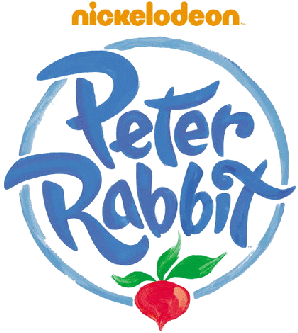
Peter Rabbit is an animated comedy children's television series for preschool children that debuted on the Nick Jr. Channel on 14 December 2012, in the United States and on CBeebies and BBC One on 25 December 2012, in the United Kingdom. It is based on the character of the same name from Beatrix Potter's children’s books. The series debuted on American TV and iTunes on 14 December 2012, with the pilot episode debuting as a Christmas holiday special, titled Peter Rabbit's Christmas Tale. The show became a regular series on 19 February 2013, in the USA. The first official DVD of Peter Rabbit was released on 28 May 2013, as a Walmart exclusive. It contains the programme's first eight episodes on a single disc. On 11 October 2013, Nickelodeon ordered a second series of 26 episodes. In Wales the series is known as Guto Gwningen and is dubbed into Welsh on S4C.


















